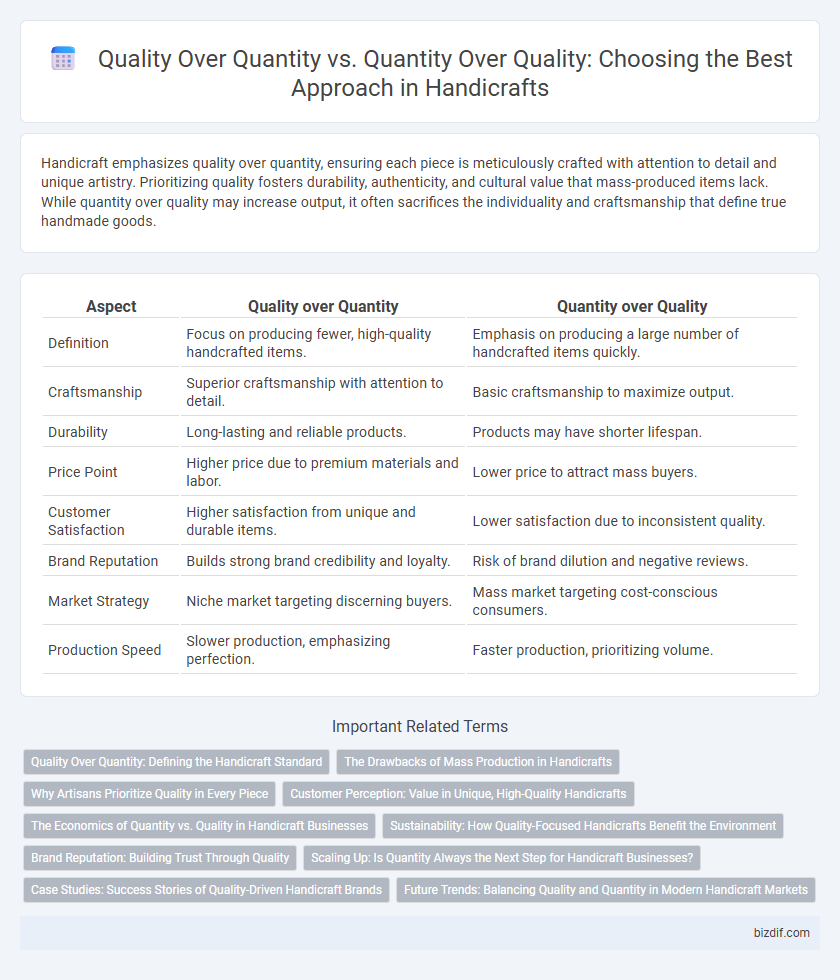Handicraft emphasizes quality over quantity, ensuring each piece is meticulously crafted with attention to detail and unique artistry. Prioritizing quality fosters durability, authenticity, and cultural value that mass-produced items lack. While quantity over quality may increase output, it often sacrifices the individuality and craftsmanship that define true handmade goods.
Table of Comparison
| Aspect | Quality over Quantity | Quantity over Quality |
|---|---|---|
| Definition | Focus on producing fewer, high-quality handcrafted items. | Emphasis on producing a large number of handcrafted items quickly. |
| Craftsmanship | Superior craftsmanship with attention to detail. | Basic craftsmanship to maximize output. |
| Durability | Long-lasting and reliable products. | Products may have shorter lifespan. |
| Price Point | Higher price due to premium materials and labor. | Lower price to attract mass buyers. |
| Customer Satisfaction | Higher satisfaction from unique and durable items. | Lower satisfaction due to inconsistent quality. |
| Brand Reputation | Builds strong brand credibility and loyalty. | Risk of brand dilution and negative reviews. |
| Market Strategy | Niche market targeting discerning buyers. | Mass market targeting cost-conscious consumers. |
| Production Speed | Slower production, emphasizing perfection. | Faster production, prioritizing volume. |
Quality Over Quantity: Defining the Handicraft Standard
Quality over quantity defines the essence of authentic handicraft by emphasizing meticulous attention to detail, superior materials, and expert craftsmanship. Handcrafted products prioritize durability, uniqueness, and artistic value, ensuring that each piece carries cultural significance and timeless appeal. This standard elevates the craft beyond mass production, fostering appreciation for the artisan's skill and preserving traditional techniques.
The Drawbacks of Mass Production in Handicrafts
Mass production in handicrafts often sacrifices intricate detail and uniqueness, leading to diminished artistic value and consumer appreciation. The mechanized processes cannot replicate the careful craftsmanship and cultural significance embedded in each handmade piece. Consequently, prioritizing quantity over quality results in uniform, less durable products that undermine the traditional essence and market reputation of authentic handicrafts.
Why Artisans Prioritize Quality in Every Piece
Artisans prioritize quality in every piece to ensure durability, uniqueness, and customer satisfaction, which ultimately builds a strong reputation in the handicraft industry. Handmade items with meticulous craftsmanship showcase exceptional attention to detail, making each product a valuable work of art rather than a mass-produced commodity. This focus on quality over quantity supports sustainable practices and preserves traditional techniques passed down through generations.
Customer Perception: Value in Unique, High-Quality Handicrafts
Customers perceive unique, high-quality handicrafts as valuable investments that offer authenticity and durability, distinguishing them from mass-produced items. Emphasizing quality over quantity enhances brand reputation and fosters long-term loyalty among discerning buyers. Handcrafted products often carry intrinsic cultural and artistic significance, increasing their perceived worth beyond mere material cost.
The Economics of Quantity vs. Quality in Handicraft Businesses
Handicraft businesses face a critical economic choice between quality and quantity, where producing high-quality, unique items often commands higher prices and fosters customer loyalty, but limits volume and scalability. Conversely, prioritizing quantity enables increased production and market reach but risks compromising craftsmanship and brand reputation. Sustainable growth in handicraft ventures hinges on balancing cost efficiencies with maintaining artisanal value to maximize profitability.
Sustainability: How Quality-Focused Handicrafts Benefit the Environment
Quality-focused handicrafts promote sustainability by utilizing durable materials and timeless designs that reduce waste and the need for frequent replacements. This approach minimizes environmental impact compared to mass-produced items that often rely on resource-intensive processes and generate excessive waste. Prioritizing craftsmanship enhances the lifecycle of products, supporting eco-friendly consumption patterns and conserving natural resources.
Brand Reputation: Building Trust Through Quality
Handicraft brands prioritize quality over quantity to establish a strong reputation for reliability and artistry, ensuring each piece reflects exceptional craftsmanship. Consistently delivering high-quality products fosters customer trust and loyalty, differentiating the brand in a competitive market. Emphasizing quality strengthens brand identity and encourages repeat purchases, ultimately driving long-term success.
Scaling Up: Is Quantity Always the Next Step for Handicraft Businesses?
Scaling up handicraft businesses often challenges the balance between quality and quantity, as maintaining artisanal craftsmanship at high volumes can compromise product integrity. Investing in skilled artisans and sustainable materials ensures the preservation of brand reputation and customer loyalty, emphasizing quality over mass production. While increasing output can enhance market reach, prioritizing craftsmanship quality sustains long-term growth and differentiates handicraft brands in competitive markets.
Case Studies: Success Stories of Quality-Driven Handicraft Brands
Artisanal brands such as Hermes and Patagonia exemplify the success of prioritizing quality over quantity, with handcrafted products that command premium prices and foster deep customer loyalty. Case studies reveal that these quality-driven brands achieve sustainable growth by emphasizing craftsmanship, durability, and unique design, contrasting mass-produced alternatives that often sacrifice longevity for volume. These success stories highlight how investing in superior materials and skilled artisans translates into higher perceived value and long-term profitability in the handicraft market.
Future Trends: Balancing Quality and Quantity in Modern Handicraft Markets
Modern handicraft markets increasingly emphasize balancing quality and quantity to meet evolving consumer demands. Artisans integrate traditional craftsmanship with scalable production techniques, ensuring high-quality products while expanding output. Future trends highlight sustainable practices and smart technologies that optimize resource use without compromising artisanal integrity.
Quality over quantity vs Quantity over quality Infographic

 bizdif.com
bizdif.com